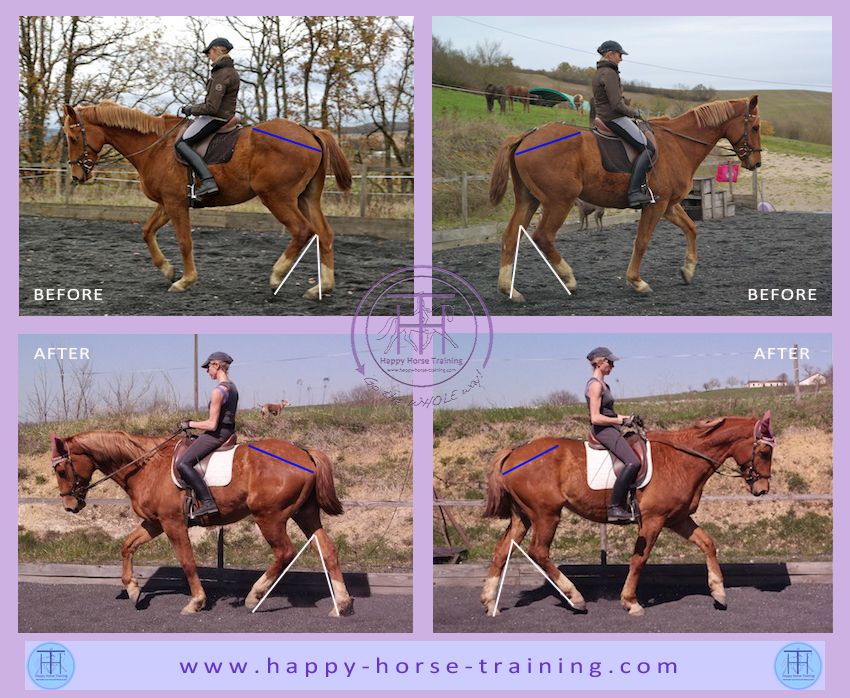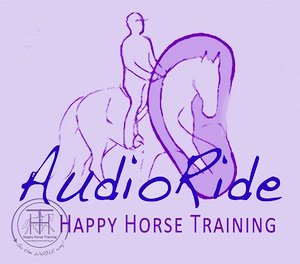The Horse's Hind legs tell the true story
The horse's hind legs are what we should be looking at to asses genuine progress in training, not the head-carriage.
This comparison shows a young horse at an early stage of training (top images) and four months later (lower images) after several periods of work in postural engagement interspersed with periods of rest.

Despite already being trained and competed in Eventing, his postural strength had not been developed in his early training, resulting in a very weak hind leg engagement and several 'evasions' based on this weakness, such as leaning on the bit.
The white lines illustrate the angles separating the hind-legs at the same moment in the stride. In the 'before' images, this angle is smaller, as the lifting hind leg was not carrying forwards underneath the ribcage, and the extended hind leg was not pushing off as strongly.
In the 'after' images, the angle between the hind legs is much greater, and the lifting hind leg is carrying forwards beyond the level of the stifle to reach underneath the ribcage. The blue lines show the angle of hip to point of buttock, indicating the engagement of the pelvis. Although this is a more subtle difference than the hind leg angles, the pelvis being a structural element of the anatomy, the angle is distinctly steeper in the 'after' images, indicating a greater tucking of the pelvis, to accompany the further-reaching hind legs. It is important to note in these images that in both the after images, the horse's head-carriage is lower, and could be misconstrued as 'less advanced' than the head-carriage in the 'before' images.
In fact,
the lower head-carriage is absolutely correct for this horse's level of
engagement (even when the nose comes slightly behind the vertical), and
it indicates a greater 'throughness' from the increased engagement of
the haunches, which manifests as more softening and stretching towards
the contact. If we were to look at these images and fixate on
the head-carriage alone, it would be easy to mistakenly conclude that
the horse is more 'on the forehand' in the lower images, and that the
work is less advanced, but the hind legs tell another story.
This is
why we must pay attention to looking at the whole horse when analyzing
work visually to avoid being fooled by the eye-catching appearance of
the front end.
As this horse's postural strength gradually
increases, for as long as he is trained on the basis of postural
engagement, he will gradually lift up more in front, as a function of
his ability to tuck his pelvis more and 'sit' on his haunches. At no
stage will it be necessary to ask him to lift up in front in any way, or
use equipment that encourages him to do so (e.g. a double bridle)
because it is whole-body engagement alone that determines the horse's
ability to lift up in front.
Return from The Horse's Hindlegs Tell the True Story to HHT Dressage Diagrams
Return from The Horse's Hindlegs Tell the True Story to the Happy Horse Training homepage
The pages on HHT are so wide-ranging and interrelated that we strongly recommend you look at the site plan to find other subjects that may interest you.
New from HHT!
AudioRide is a series of exercises designed to listen to while you ride.
Audio descriptions guide you through each step of developing a balanced, dynamic connection with the horse through your position.
This truly innovative learning tool gives you a whole new way of being guided in your riding, in a calm, clear, step-by-step way.
Free Download! Introductory Exercise: Riding in the Now
The Gymnastic Rider eBook
Now available exclusively from HHT!
A unique, comprehensive guide to practical rider biomechanics. This professionally produced eBook takes the rider through the process of developing their body in the specific way that brings the horse's movement into harmony and balance, without force and constraint. Click here for full details, and to download the 15-page introduction to the book for free.
Join the Happy Horse Training group on Facebook!
See and share topical info, news and photo's, and take part in lively discussions.
Click here to go to the HHT group (make sure you log into fb first) and then click on the 'join' button at the top of the page.
Join the Whole Horse Newsletter!
HHT's free monthly newsletter giving you wide-ranging and intelligent insights into holistic horsemanship.
Just enter your details below to join.
Free bonus on the riding position with all new subscriptions: Ten Top Tips To Instantly Improve Your Connection With Your Horse.
Click here to see back issues of The Whole Horse newsletter
Train Your Horse
The Holistic Way
How To Train A Horse Without Force
is a unique guide to training horses through energetic connection and
gymnastic training. Part 1 covers everything on the ground, from
handling to the lungeing technique that develops strength, straightness
and engagement. Comes with a free eBook supplement on Horse Trauma.
Click here for more details.
"As a student of Zen Buddhism for nearly three decades, I've often wondered when someone was going to write the book on Zen and the art of horsemanship, and I think that your emphasis on mindfulness and energy connection gets right at the heart of the matter."
- Prof. Teresa Lloyd, U.S.
Do You Have
A Horse Story
To Share On HHT?
So many people have been through
wonderful experiences with horses, whether in training or otherwise. If
you've made a change in a horse's life - or one has made a change in
yours - tell us about it here.
Learn The Natural Barefoot Trim - The Simple Way
The Simple Seven-Step Natural Trim is a comprehensive step-by-step guide to a cutting-edge barefoot trim. Click here to find out more.
What people say about HHT:
"The riding instruction is outstanding, if instructors in the UK taught this way there would be a lot of happy riders and horses."
"The riding tuition exceeded my hopes and expectations by a long way; giving me an exciting new facet to horsemanship which is lighter. more subtle, more elegant and more meaningful. It is as if a new door has opened bringing more sunlight and air."
"My goodness - what a change has taken place in my riding. I think that I'm starting to sit 'into' the horse rather than on top of him. I felt my horse's movements in a way that has almost never happened before"
Click on Testimonials for more










New! Comments
Anything to say about this page? Leave your comment in the box below.